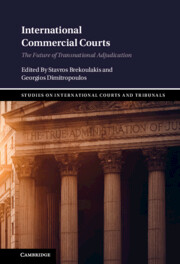Book contents
- International Commercial Courts
- Studies on International Courts and Tribunals
- International Commercial Courts
- Copyright page
- Contents
- Contributors
- Foreword
- Preface
- International Commercial Courts: The Future of Transnational Adjudication – An Introduction
- Part I A Contextual Perspective to International Commercial Courts
- 1 The Role of International Commercial Courts in Commercial Dispute Resolution
- 2 International Commercial Courts
- 3 Transnational Adjudication and the Court of Justice of the European Union
- 4 International Commercial Courts
- Part II Jurisdiction, Applicable Law and Enforcement of Judgments
- Part III Procedure, Function, Organization
- Part IV The Interplay between International Commercial Courts and Other Dispute Resolution Fora
- Part V International Commercial Courts and Global Governance
- Index
3 - Transnational Adjudication and the Court of Justice of the European Union
from Part I - A Contextual Perspective to International Commercial Courts
Published online by Cambridge University Press: 14 April 2022
- International Commercial Courts
- Studies on International Courts and Tribunals
- International Commercial Courts
- Copyright page
- Contents
- Contributors
- Foreword
- Preface
- International Commercial Courts: The Future of Transnational Adjudication – An Introduction
- Part I A Contextual Perspective to International Commercial Courts
- 1 The Role of International Commercial Courts in Commercial Dispute Resolution
- 2 International Commercial Courts
- 3 Transnational Adjudication and the Court of Justice of the European Union
- 4 International Commercial Courts
- Part II Jurisdiction, Applicable Law and Enforcement of Judgments
- Part III Procedure, Function, Organization
- Part IV The Interplay between International Commercial Courts and Other Dispute Resolution Fora
- Part V International Commercial Courts and Global Governance
- Index
Summary
The keystone of the European Union (EU) judicial order is Article 267 of the Treaty of the Functioning of the European Union (TFEU) whereby a court or tribunal of a Member State can, and in certain circumstances must, refer to the Court of Justice of the EU (CJEU) for a preliminary ruling a question of EU law that is necessary in order to enable the national court to give judgment in the case before it. This chapter explains what bodies, including an arbitral tribunal, constitute a court or tribunal for the purposes of that Article. It then examines the relationship between investor-state dispute resolution mechanisms, contained in the EU trade and investment agreements, and the EU judicial system. Finally, the chapter considers how the new national commercial courts that have been established in some Member States of the EU are likely to operate within the EU judicial system.
Keywords
- Type
- Chapter
- Information
- International Commercial CourtsThe Future of Transnational Adjudication, pp. 73 - 88Publisher: Cambridge University PressPrint publication year: 2022



